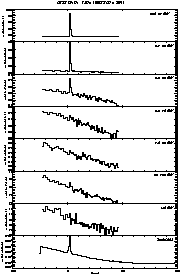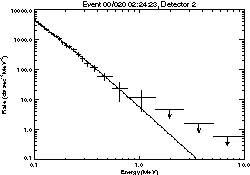Back To OSSE Solar Flare Web Page
2000 January 20 (C4.1)
A GOES C4.1 solar flare occurred on 2000 January 20. The location of the flare on the Solar surface is not known due to lack of an accompanying H-alpha event. The soft X-ray flux began at 2:21 (8460 s), peaked at 2:26 (8760 s) and ended at 2:30 (9000 s) UT (GOES Geophysical Data Web Site). OSSE received a BATSE transient trigger at 8642 s and the four OSSE detectors slewed to the scan-angle position of the Sun and initiated +/- 4.5 degree on-source-off-source viewing strategies.
Significant emission to above 1 MeV was observed during a ~33 s time interval (8663-8696 s). Count rate time profiles in various energy windows at a temporal resolution of ~8 s are shown in Figure 1. A representative count spectrum is shown in Figure 2. A single power law provided an adequate fit to the data. No evidence for nuclear line emission was observed. The total fluence above 50 keV and 1 MeV was 86 +/- 1 and 0.8 +/- 0.6 photons cm-2, respectively. A fit for the 2.223 MeV neutron-capture line showed no significant emission with a 2-sigma upper limit of 0.4 photons cm-2.
The 2.223 MeV line-to->1 MeV fluence ratio varies considerably from flare to flare depending on the flare's accelerated proton-to-electron ratio and location on the Sun (due to limb attenuation of the 2.223 MeV line). For the large flare of 1991 June 4 (located at N30E70) which had a strong nuclear component, this ratio was about 0.3. Based on the measured >1 MeV fluence of the January 20 flare, we would expect a 2.223 MeV line fluence of 0.24 +/- 0.18 photons cm-2 if the flare were similar to the June 4 flare. A measured fluence significantly less than this would imply little or no nuclear emission. The measured upper limit to the line fluence cannot rule out nuclear emission from the January 20 flare.
 Figure 1 |
 Figure 2 |